
IRIS login | Reed College home Volume 94, No. 1: March 2015
Letters

Around the World in Weighty Phrases
“Readers from across the globe,” declares the editor of Reed, “alerted us to a carnival of errors in the last magazine.”
U.S. spies have been “conducting surveillance in the online games played by millions of people across the globe”—thus were my eyes assaulted by a New York Times story one morning. Another headline read, “A Moment of Unity as the Tributes Flow from Across the World”—modified, mercifully, to “Around the World” in the Times online edition.
Don’t know much about geography . . . Many people, perhaps even a majority, believe that the earth is round. The last time I used such a medieval phrase was as a young child, and I was quickly corrected by my mother. How is it that the flat-earth society is suddenly resurgent? Curious, I did a little research. How often in the past, I wondered, were the phrases “across the world” and “across the globe” used in the Times (as an indicator of the media in general), as opposed to the “around” versions.
Using the Times online search facility, I came up with some illuminating results: For most of the 20th century, the annual frequency of “across” rested comfortably in the 1% to 5% range, with an occasional anomalous year. An exception was the World War II period, when there was a spike to nearly 10%, but that increase tapered off by midcentury. Stories about Jules Verne’s Around the World in 80 Days and Howard Hughes’ flight around the globe did not skew the results. On the other hand, reviews of the 1930 movie Across the World with Mr. and Mrs. Martin Johnson produced a visible blip in the data. Then, suddenly and inauspiciously, with the inauguration of George Bush the Lesser, the rate of “across” leaped to the double digits, peaking above 30% for Bush’s two final years. As suddenly as Bush was out of office, the rate dropped to 16%, and as the Obama years progressed, into the single digits, though the damage seems to have been done, and we’re still hovering around 9%.
Editor's Note: Although it is deeply disheartening to be thus associated with the George W Bush adminstration, I will take this as a round to bear.

Carnival of Errors
From the Editor: Readers across the globe alerted us to a carnival of errors in the last magazine. In “Quadrivial Pursuit.” on the multiple choice, the answer to question 2 was mismarked as A, the 1968 occupation of Eliot Hall; in fact, it should have been B, students wanted a black studies program. Second, we said that Prof. Stanley Moore refused to appear before HUAC; in fact, he did appear but refused to answer questions. Third, we claimed that the Columbus Day Storm of 1962 was divine retribution for Reed staging a mock crucifixion at a football game; however, it appears more likely that if divine retribution was involved, it was caused by Reed thumping the team from Columbia Christian 19-7 (historical evidence suggests that the mock crucifixion was staged in 1959). Fourth, in “Prime Exponent,” we mangled an equation, thereby inadvertently overstating Prof. Joe Roberts’ stay at Reed by 192 years. Finally—finally—we ran the wrong photo of Vern Rustala ’56. We extend our apologies for the errors and our gratitude to everyone who wrote to us about them.

Prime Exponent
I remember little of my education at Reed College better than my calculus class with Joe Roberts [1952–2014].
I remember sitting in the classroom at Reed, watching Professor Roberts enter. He ran his hand through his hair, offered his straightforward greeting, “How is mathematics today?” and then moved, as in a dance, to an extraordinary mathematical journey on the blackboard.
I’d been blessed since elementary school with more than one extraordinary teacher of mathematics, but I never held court as head of class. It has always been a bit of mystery to me that I ever was allowed into Professor Roberts’ class, and to this day when people mention calculus I find my intellect feeling a bit fuzzy. Sometimes I find myself wondering, was I even there? In calculus class? Reed College?
Then I read Bill Donahue’s article “Prime Exponent” in the September 2014 edition of Reed, and I knew, yes, I was there. I was one of the many lucky students fortunate enough to experience this extraordinary teacher.
I often remember taking the final exam for that course—delightful! I never learned, did I pass or fail? I never received any grade from Reed College or from any teacher in the school. So I’ve never known, should I be dismayed by my profound lack of understanding or delighted because I passed the test?
I do know that I have carried into my life and into my work a profound appreciation for numbers, and I have tried as an elementary grades Waldorf schoolteacher to bring to my students some of the awesome and beautiful truths of numbers that Joe Roberts revealed to me.
I believe that some of those truths appear in my paintings, as well, but that would take more than 300 words to relate.

Worth a 1000 Words
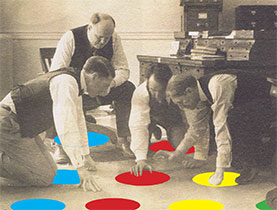
You question (December 2014) what those four early faculty are up to. Recent discovery of this old chromatolithograph makes it clear.

Brain Waves
My wife and I laughed when we saw the cover of the latest (excellent) Reed magazine. In 1968, when she and I first met, I was working with an ancient EEG machine in the basement of Eliot, exploring the potential of biofeedback as a tool for exploring human consciousness. (You wrote about my thesis in “What Life Can Compare with This? Sitting Alone at the Window, I Watch the Flowers Bloom, the Leaves Fall, the Seasons Come and Go”—the thesis title — in Gary Wolf’s February 2002 article (in Reed) about me.
The use of brain waves as a tool for exploring and controlling consciousness was a new idea in 1968. Joe Kamiya at Langley Porter Neuropsychiatric Institute had reported that trained Buddhist meditators had exhibited high levels of the 8-12-cps “alpha frequency” as measured by electroencephalography, and that untrained subjects had learned to emit higher levels of alpha when a tone was sounded whenever alpha appeared. Not only might we be able to use electronic methods to map consciousness, but it appeared that by becoming aware of our brain’s unconscious processes, we might be able to learn how to control them.
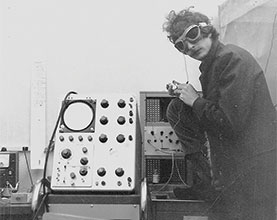
There was an ancient EEG machine in the psych department. These days, brain waves are recorded digitally and displayed on a screen. In 1968, these machines spewed out fan-folded reams of white paper at a frightening rate. I knew nothing about electronics. My roommate, the late Richard Crandall ’69, built the feedback apparatus.
It turns out that EEG neurofeedback has real but limited usefulness, and using it to map consciousness is akin to sitting on Neahkahnie Mountain and attempting to map the ocean floor by looking at the waves—useful, yes, but extremely limited.
I do have some authentic photos of me and some of the apparatus. Although it appears that they were taken in a lighthearted moment.

Prexy's Midnight Runner
I was delighted to read “Prexy Gets Facelift” (Reed, December 2014). The historical account was nearly right, but missed a detail of supreme importance (to me, anyway). True, in 1958 the men’s dorm was removed from Prexy and the music program was installed, with piano taught in the big room, first-floor northeast corner of the building, and nearly all the rest of the rooms used for practice. However, contrary to the claim that “the building was declared unsafe as a residence,” in fact it remained a residence for years to come. There was a three-room apartment on the second floor (again, northeast corner) containing a living room with fireplace, a bedroom/study, and a full private bathroom. This apartment was occupied by the building’s student-custodian, who lived there rent free in exchange for unlocking the front door at 7 a.m. every day, locking it again at 11 p.m., and vacuuming the whole building once a week (with special attention to the piano room). I held this job my senior year, 1961–62, and oh-la-la, was that apartment ever a superchallenge to the open-door policy. It was also a challenge to the student-custodian, who could not roust himself at 7 a.m. most days, so was awakened by shouting from below and heavy rapping on the front door. Musicians, you gotta love ’em . . . and I did!

Exploring the Labyrinth
My how times change. Never in various forays within the steam tunnels of Reed did I foresee them becoming venues for freshman orientation. Nor did I envision the smiling faces of coeds, all in a row, leaving their names as did craftsmen behind the walls of the Sistine Chapel. But carefully did you reveal some and leave much unsaid. You mention Eliot Hall, the Old Dorm Block, and Physical Plant, but nary a word of the other significant buildings to which, through steam tunnels, may be gained entry. You mention “sentries and locks,” but omit other access available to the quiet and unobtrusive. A reference to “surreal artwork” doth not justice do to some of the sculpture left in situ. Finally, the phrase “difficult to navigate” doth not adequately describe the three-inch-high stalagmites dripped from the mesh ceiling, which make interesting the long hands-and-knees traverse to a particularly guarded location.
A question then. Is the orientation through high and wide tunnels naught but an interesting sidelight for freshmen, or a ruse, a gambit, to distract the adventurous mind from what else may lie beneath the lawns? ’Twas a time when a small and select group, styling itself “Trophies Anonymous,” explored the nether regions of the campus. Quiet, discreet fun was had by all.

Best Profs Ranking
Congratulations to Reed for its first-place status in the Princeton Review about student rankings of their professors! A great performance and one with which I heartily agree. My professor in Humanities 11 & 21 was Richard Jones [history 1941–86], and he gave me a lifelong appreciation of the subject. I read extensively and most of it is in the history and other social sciences areas.

Impoverished Cookery
A thread in the (unofficial) Reed group on Facebook brought up the continuing existence and availability of Jay Rosenberg’s wonderful Impoverished Students’ Book of Cookery, Drinkery, and Housekeepery (a classic piece of Reediana that seems due for a profile in Reed magazine). It’s a wonderful (if somewhat dated) book that covers some inexpensive recipes, some home- brewing basics, multiple-household budgeting, and more. It is still available for a mere $10 per book in the Reed bookstore, with $4.40 from each sale going to the Jay Rosenberg Cookbook Scholarship Fund. My first exposure to the book was when I received it as a high school graduation present, and I invite the readers of Reed magazine to join me in making commitment to include a copy of this book in every high school and college graduation and housewarming present we give. If we do this, in addition to whatever charitable contribution we make to the college (whether specifically to the financial aid fund or untethered), we can give a useful (and entertaining) book to those who might find it useful while helping Reed edge slightly closer to being able to adopt a need-blind admissions policy.

Out of the Shadows
I have pondered writing this letter for some time but feared that it would bring unpleasant consequences and so did not follow through. At this point I have decided it needs to be written anyway.
Your magazine includes features on Reed, Reed graduates, and the Reed experience—for the most part positive. Yet for some of us, women in particular, the Reed experience was marred by institutionally tolerated sexual misconduct that will forever influence our lives and feelings about Reed. This misconduct meant that in a place where the life of the mind was said to be paramount, we were treated instead as bodies.
I attended Reed from 1981-85 and in those four years I myself was subject to some inappropriate conduct by male faculty, I was also told flat-out by a male professor I knew that he was sleeping with at least one of his Hum 110 students, and a close friend endured sexual abuse by her thesis advisor that qualified as felonious. In the latter case, the professor was ultimately fired, but with no black mark on his record, allowing him to continue his career at another institution.
Recently I had a conversation with former Reed president Steve Koblik, whose term from 1992 until 2001 occurred well after my graduation. He shared stories indicating that in the decades prior to his term sexual predation by male faculty on female students was an open secret. (Though President Koblik and the college can be lauded for implementing new policies regarding sexual misconduct during his tenure, for women of earlier generations the damage had already been done.) If you publish this letter I have no doubt that you will hear from other Reedies whose experiences second both my account and his assessment of those earlier days.
Especially after reading “Out of the Shadows” (Reed, December 2014), on a Reed graduate who works toward justice for children who were sexually abused, I am asking myself these questions: When will the sexual exploitation that many Reed women experienced come “out of the shadows”? Will there ever be a statement by Reed as an institution that such conduct was wrong and that it should never have been tolerated?
Before closing I would like to emphasize that I had many fine professors at Reed of both genders. I am by no means impugning all of Reed’s faculty and administrators. However, the trust that female students had in Reed was, in too many instances, not returned with policies and actions that would have protected us from those who were willing to abuse their power.
It is hard to put this history behind us when it remains unacknowledged. If any school can do this is in a thoughtful way, it should be Reed, and I am hopeful that, in some future issue of Reed magazine, I may see such an attempt to be truthful about the past and embrace a more equal future.
Editor's Note: Thanks for raising a difficult but important issue. According to Comrades of the Quest, romantic relationships between students and professors were common in the 1950s and 1960s. The first official statement I have found condemning this sort of thing is a 1980 memo from acting president George Hay which makes clear that sexual harassment—as it was then understood—was unacceptable. But it seems that during the 1980s the faculty as a whole was reluctant to declare that any sexual relationship between professor and student, even if apparently consensual, constituted an abuse of power. The debate was doubtless complicated by the fact that several professors were married to former students. In 1993, the faculty revised its policy thus: “Because those who teach are entrusted with guiding students, judging their work, giving grades for courses and papers, and recommending students, instructors are in a particularly delicate relationship of trust and power. This relationship must not be jeopardized by possible doubt of intent, fairness of professional judgment, or the appearance to other students of favoritism. It is therefore inappropriate for faculty to have romantic or sexual relationships with students.” The current policy is even more emphatic.

Fossil Fuels
I was surprised to find the editor defending the decision of the board of trustees not to divest from fossil fuels as “protecting academic freedom” (Letters, December 2014). Who was supposedly persecuted for their ideas? The only freedom protected by the trustees’ action is the freedom of capital to pursue profit without restriction. What impulse made the editor invoke academic freedom?
I suggest that the editor was motivated by the need to make the action of the trustees correspond to the mission of the institution it supports. As I understand it and experienced it, Reed is committed to thinking critically about issues that matter and applying the results of that thinking in the real world. It feels wrong if Reed is supported by investments that are used to bring about what the scientific consensus believes is a climate disaster, and to promote lies and distortions that discredit critical thinking about that disaster and their role in creating it. Therefore we must be acting to protect academic freedom. That makes us feel better.
The need for compatibility between mission and action (in this case the actions taken to support the institution financially) is real. So is the need to develop financial support to accomplish the mission. I do understand the “slippery slope” argument. If they agree to divest from fossil fuels, how will the trustees deal with what could become a never ending stream of demands to divest from other industries? Corporations exist to pursue profit, and most of them engage in at least some unsavory activities to that end.
I suggest that the board of trustees solve this dilemma by reflecting on the mission of Reed. It is not to evaluate and rule on the public benefit of every corporation in which they may invest the endowment, but neither is it to blindly provide financing to institutions that are totally incompatible with its mission. I suggest the following as possible principles which would mandate divestment from fossil fuels without venturing too far out onto the “slippery slope”:
1) The divestment should be in response to an issue of global importance. Many injustices exist, but few have the reach of negatively impacting all of humanity (and most other species as well).
2) The target of divestment should have proved itself resistant to taking reasonable action or reform.
3) There should exist a movement with some momentum and chance of success (the Rockefellers have joined the fossil fuel divestment movement).
4) There should be some risk that if the divestment is successful that it will negatively affect the college’s investments. (In my previous letter [December 2014] I argued that by taking what is really an ideological stand that money must follow its own rules, the board of trustees was overlooking risks that should be taken into account in making wise investment decisions. )
The trustees of course will need to develop their own guidelines. It is a difficult task and they will not be able to avoid criticism from those scrutinizing their decisions. Still, they need to “person up” and make the tough calls to keep Reed’s investments consistent with its mission.
Editor's Note: As I see it, my role is not to defend but to explain. Last year I had the opportunity to watch several trustees discuss the question of divestment with students. In that session, it was clear to me that the trustees were concerned about the potential impact of divestment on academic freedom because of the “slippery slope” argument. Thanks for focusing on this point in your valuable contribution to the debate.

Poet of Ordinary Mysteries
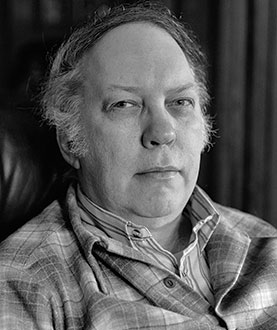
Our obituary of poet Vern Rutsala ’56, written by poet and Hubbub editor Jim Shugrue and printed in the September 2014 issue of Reed, mistakenly included the wrong photo. Here’s the real Vern, along with our apologies to the family. An additional image of Vern, taken by Maxine Scates, is online.
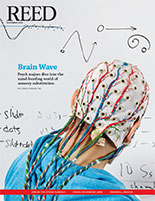
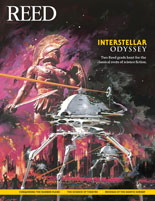
LATEST COMMENTS
steve-jobs-1976 I knew Steve Jobs when he was on the second floor of Quincy. (Fall...
Utnapishtim - 2 weeks ago
Prof. Mason Drukman [political science 1964–70] This is gold, pure gold. God bless, Prof. Drukman.
puredog - 1 month ago
virginia-davis-1965 Such a good friend & compatriot in the day of Satyricon...
czarchasm - 4 months ago
John Peara Baba 1990 John died of a broken heart from losing his mom and then his...
kodachrome - 7 months ago
Carol Sawyer 1962 Who wrote this obit? I'm writing something about Carol Sawyer...
MsLaurie Pepper - 8 months ago
William W. Wissman MAT 1969 ...and THREE sisters. Sabra, the oldest, Mary, the middle, and...
riclf - 10 months ago